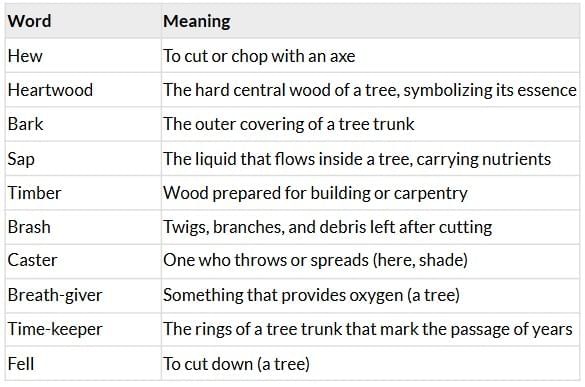Summary: Heartwood | Gul Mohar Class 7 PDF Download
| Table of contents |

|
| About the Poet |

|
| Detailed Summary |

|
| Moral / Message |

|
| Vocabulary Table |

|
About the Poet
The poem Heartwood is written by Clare F. (Cl Fa), a modern poet whose works often focus on nature and human responsibility towards it. In this poem, she gives voice to a tree, making it speak to the woodcutter. Through this powerful perspective, the poet highlights the importance of protecting the environment and respecting the life-giving role of trees.
Detailed Summary
Stanza 1
Would you hew me
To the heartwood, cutter?
Would you leave me open-hearted?
Put an ear to my bark, cutter,
Hear my sap's mutter,
Mark my heartwood's beat, my leaves' flutter.
In this stanza, the tree directly addresses the woodcutter, asking whether he will cut it down to its very core, leaving it wounded and exposed. It appeals to the woodcutter to pause and listen to its life — the flowing sap, the steady beating of its heartwood, and the movement of its leaves. The tree is presented as a living being with feelings and vitality.
Stanza 2
Would you turn me to timber, cutter?
Leave me nothing but a heap of logs, a pile of brash?
I am a world, cutter,
I am a maker of life -
Here, the tree questions whether the cutter only sees it as timber to be used. It reminds him that if it is felled, it will become nothing more than logs and waste. The tree then declares that it is not just wood, but an entire living world in itself, supporting countless lives and creating balance in nature.
Stanza 3
Drinker of rain, breaker of rocks,
Caster of shade, eater of sun,
I am time-keeper,
Breath-giver,
Deep-thinker, cutter;
I am a city of butterflies, a country of creatures.
In this stanza, the tree describes its many roles in nature. It drinks rain and absorbs water, its roots break rocks over time, it gives shade, and it uses sunlight to produce energy. It marks the passage of time through its rings, provides oxygen for all living beings, and symbolizes deep wisdom. It is home to butterflies and countless other creatures, making it a world of life on its own.
Stanza 4
But my world takes years to grow,
Cutter, and seconds to crash;
Your saw can fell me, your axe can bring me low.
This stanza highlights the contrast between growth and destruction. The tree explains that while it takes many years, even centuries, to grow and develop into a life-giving force, human tools like saws and axes can destroy it within seconds. This reveals the fragility of nature when faced with human greed and thoughtlessness.
Stanza 5
Do you hear these words I utter? I ask this of you -
Have you heartwood, cutter?
Have those who sent you?
The final stanza is an appeal to the cutter’s conscience. The tree asks if the woodcutter has “heartwood” — which here symbolizes compassion, sensitivity, and inner strength. It also questions whether those who ordered the cutting have any real concern for life. The tree’s plea is not only to save itself but to awaken the humanity in people.
Moral / Message
- The poem teaches that trees are not just wood for human use, but vital parts of our ecosystem.
- They give life, provide shelter, offer oxygen, and sustain countless living beings.
- Destroying them for short-term needs can have permanent consequences.
- The poem urges people to think deeply before cutting down trees and to develop compassion and responsibility towards nature.
- It reminds us that true humanity lies in preserving life, not destroying it.
Vocabulary Table

FAQs on Summary: Heartwood - Gul Mohar Class 7
| 1. Who is the poet of "Heartwood" and what are some key themes in their work? |  |
| 2. What is the moral or message conveyed in "Heartwood"? |  |
| 3. Can you provide a detailed summary of "Heartwood"? |  |
| 4. What vocabulary words are significant in understanding the poem "Heartwood"? |  |
| 5. How can studying "Heartwood" benefit students in their understanding of poetry? |  |














